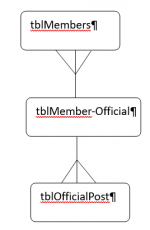John O'Malvern
New member
- Local time
- Today, 18:10
- Joined
- Mar 25, 2024
- Messages
- 5
SORRY I didn't mean to post this as a sticky! Admin, please move, as I don't seem to be aable to delete it.
(Embarrased!)
I expect to take over a datavbse of 'club' members, actually a local group of a national association.
This local 'club' has its own committee, with a chairperson, treasurer, and secretary etc. Members come and go from htese 'officials' posts.
Many members can be a treasurer [eg], at different times. And one member can hold many different official-posts at different times.
I think to record this correctly I need, tblMembers many-to-one tblMember-Official one-to-many tblOfficialPost, with fields for startdate and enddate in the tblMemberOfficial.
Am I right?
is it of any practical use if I bother with this???
(Embarrased!)
I expect to take over a datavbse of 'club' members, actually a local group of a national association.
This local 'club' has its own committee, with a chairperson, treasurer, and secretary etc. Members come and go from htese 'officials' posts.
Many members can be a treasurer [eg], at different times. And one member can hold many different official-posts at different times.
I think to record this correctly I need, tblMembers many-to-one tblMember-Official one-to-many tblOfficialPost, with fields for startdate and enddate in the tblMemberOfficial.
Am I right?
is it of any practical use if I bother with this???

